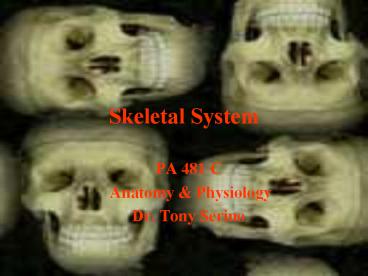Skeletal System - PowerPoint PPT Presentation
1 / 39
Title:
Skeletal System
Description:
Skeletal System PA 481 C Anatomy & Physiology Dr. Tony Serino Skeletal System Composed of mineralized CT and their supporting structures including: bone, cartilage ... – PowerPoint PPT presentation
Number of Views:102
Avg rating:3.0/5.0
Title: Skeletal System
1
Skeletal System
- PA 481 C
- Anatomy Physiology
- Dr. Tony Serino
2
Skeletal System
- Composed of mineralized CT and their supporting
structures including bone, cartilage, ligaments,
tendons, and bursae - Functions support, protection, homeostasis
(specifically Ca regulation) and hempoiesis
3
General Osteology Composition
- Cells originate from mesechyme (undifferentiated
mesodermal cells) - Extracellular Matrix
- Ground substances water, salts, cementing
substances, glycoproteins - Fibers collagen and elastin
4
Cartilage
- Avascular CT
- Appositional and interstitial growth possible
Perichondrium
Chondroblast
Lacuna
Chondrocyte
Matrix
5
Hyaline Cartilage
6
Elastic Cartilage
7
Fibrocartilage
8
Cartilage in Adult
9
Bone
- Heavily mineralized CT
- Highly vascular
- Principle storage area of Calcium
- Provides strength and structural support to body
10
Long Bone Anatomy
Fig. 6.3
11
Compact vs. Spongy Bone
Trabeculae
12
Bone Histology
Fig. 6.5
13
Haversian System Lamellae
14
Ossification
- Development of bony tissues
- First bone to form is woven (premature) bone
- This is eventually replace by mature bone
(compact or spongy bone) - Two methods for creating bones
- Intramembraneous (bone replaces mesoderm
membrane) - Endochondral (bone replaces an intervening
cartilage model)
15
Intramembranous Ossification(membrane bone)
16
Endochondral Ossification(replacement bone)
17
Epiphyseal (Growth) Plate
- Reserve Cartilage (distal perichondrium)
- Proliferating Cartilage(Growth zone)
- Hypertrophic zone(Transforming zone)
- Calcified matrix(Osteogenic zone)
18
Epiphyseal Plate
19
(No Transcript)
20
Fracture Healing
21
Osteoporosis
Osteoporotic
Normal
22
Divisions of Skeletal System
Axial Skeleton
Fig. 7.1
23
Appendicular Skeleton
Fig. 7.21
24
Types of Bones
Long Bones
25
Short Bones
26
Flat Bones
27
Irregular bones
28
Sesamoid Bones
29
Accessory BonesWormian (Sutural) Bones and
other supernumerary bones
Results from failure of separate ossifications
centers to fuse (common in foot and
hand) Heterotropic bones arise in soft tissue
where bones not normally present
30
Articulations
- Functional Classifications
- Synarthrotic (immovable)
- Amphiarthrotic (slightly movable)
- Diarthrotic (movable)
- Structural Classification
- Fibrous held by fibrous tissue
- Cartilaginous held by cartilage
- Synovial synovial cavity within joint
31
Suture (synarthrotic, fibrous joint)
Found in bones of skull
32
Gomphosis (synarthrotic, fibrous)
Ligament cemented to tooth surface
33
Syndesmoses (amphiarthrotic, fibrous)
34
Synchondroses (Synarthrotic, cartilaginous)
Epiphyseal Plate
35
Synchondroses (synarthrotic, cartilaginous)
36
Symphyses (amphiarthrotic, cartilaginous)
Includes pubic symphysis
37
Synovial diarthrotic joints
- The synovial membrane filters the blood to create
synovial fluid - This fluid lubricates and nourishes the joint
- Some joints may have an additional wedge of
cartilage within the joint (menisci)
Fig. 8.3
38
Bursae and Tendon sheaths
39
Arthritis

